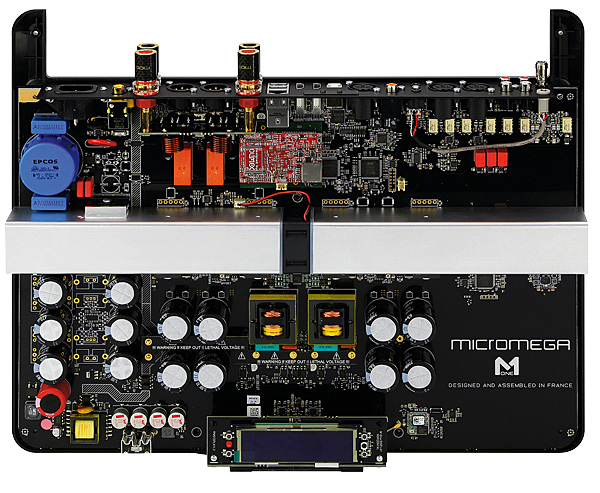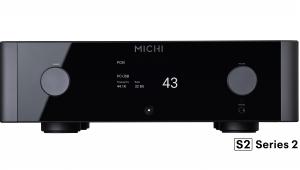Micromega M-150 DAC/amplifier Page 2
Going Up The Wall
And there's one more twist in the tale of the M-One series: although available in standard with its aluminium casework anodised in either silver-grey or black, via the Micromega Custom Finish Program you can have it in a range of alternative hues should you wish. A colour palette to match Focal's loudspeakers includes Carrara White, Black Lacquer, Imperial Red, Electric Orange, and Nogaro Blue. These are all available for a £600 premium, while for £800 extra you can choose any one of the 180+ shades on the industry-standard RAL colour chart.
The final option is a £89 wall-bracket to mount the amplifier flat on a wall – just as you can the models from that other French company! For that purpose the M-150 has two displays, one conventionally placed on the slimline front panel, the other on the top-plate just above it.
Connected up using those deeply recessed sockets, the amplifier fires up with minimal fuss, pausing only to stabilise before the company logo gives way to an indicator of the selected input.
That done, the MARS process is simple and self-explanatory, requiring nothing more than the amp, the microphone and the provided remote control, even if the five second pause at each step to allow you to clear the area requires you to be a bit quick on your toes.
![]() Driving On Auto
Driving On Auto
Once the measurements have been made and the M-150 has done its sums, you can turn the process on and off, and select between 'Auto', which is the system's best guess while retaining the characteristics of your speakers, or 'Flat', which aims to do just what it suggests, especially in the bass region. (If Micromega's engineers are reading this and planning an extension of MARS into their very nicely done control app, I'd be fascinated if some feedback could be given on the phone/tablet screen to show just what changes the system is making to the sound.)

For what it's worth, I felt the 'Flat' setting made the music just a little too uninteresting and maybe even a bit thin, while the 'Auto' setting did a much better job of tightening up the bass without robbing it of extension, and in the process revealed more of the midband and treble, and their contribution to the focus and three-dimensionality of the soundstage. But then the initial – and lasting – impression the M-150 creates is of an amplifier that carries all its considerable flexibility and complexity very lightly, doing that thing of providing a very direct communication of what's being played.
Whether with vinyl or sources connected via analogue or the battery of digital inputs, the M-150 demonstrates both generous detail and a solid grip on the speakers, making a wide range of music spring to life in a highly impressive manner. Playing the recent Channel Classics release of Vivaldi's 'Four Seasons' in DSD [CCS SA 40318; from NativeDSD.com], the M-150 relishes a recording as sparkling as the performances, its tight and beautifully integrated presentation delivering a sound as fast as it is clean, and as weighty as it is agile and dynamic.
Detail In Abundance
This is an amplifier to please those who seek to hear every detail in a recording, but just as relevant to listeners wanting no more than to immerse themselves in a performance and relish the artistry. Play a set with plenty of taut bass and superbly recorded instruments, such as Béla Fleck and The Flecktones' Live Art [Warner Bros 9 46247-2], and the M-150 is as convincing in the way it conjures up the live atmosphere as it is when delineating the snap and slap of Victor Wooten's bass strings on his extraordinary solo improvisation segueing into 'Amazing Grace'. And with Fleck's masterly medley of 'Early Reflection', a little Bach and 'The Ballad Of Jed Clampett' (yes, really!) the Micromega amp is able to show just how nimbly it can handle lightning picking and deliver it to fine effect.
So this is an amplifier with real all-round ability: load up ZZ Top's 4CD Chrome, Smoke & B-B-Q [Warner Bros 8122-78176-2] and it's as adept with the stripped-down blues of some of the earlier tracks as it is chugging out the Texas boogie of 'Cheap Sunglasses' or 'I'm Bad, I'm Nationwide'. What's more, this slimline amp will play as hard as you want without losing its composure – if it sounds hard and dirty, it's probably because that's how it's meant to be. And if y'all got a problem with that, boy, etc, etc...
Switch swiftly to Martin Helmchen's masterly reading of Beethoven's Diabelli Variations [Alpha 386; 96kHz/24-bit], and the wonderfully light touch of the performer on his Steinway is all too apparent, as is the sense of the pianoforte standing in a real space. True, some may wish for a sound with a little more smoothness than the M-150 can muster, but to these ears the abundance of detail on offer here contributes to the appreciation of a performance, rather than detracting from it.
Hi-Fi News Verdict
Its styling and provenance may suggest comparisons with that other French amplifier range, but the M-150 is very much une autre paire de manches, thanks to its distinct technology and facilities. It's remarkably capable, flexible and well-sorted, the MARS room correction is convincing, and the performance is similarly impressive: able to sound at turns lusty and supremely delicate, and above all consistently in control.
























































